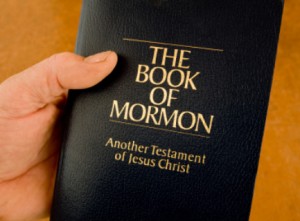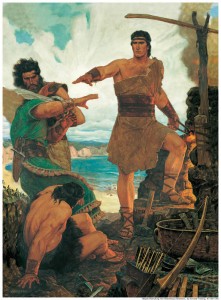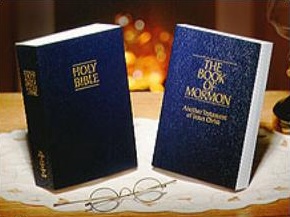 Evangelical professor and author Philip Jenkins, in addition to teaching and authoring books, blogs at The Anxious Bench. He has published an interesting series of articles over the past few months that examine the Book of Mormon as a historical text. The series began when he used the Book of Mormon as an illustration of previous posts discussing “fringe and mainstream ideas in scholarship.” In his May 17 blog he wrote,
Evangelical professor and author Philip Jenkins, in addition to teaching and authoring books, blogs at The Anxious Bench. He has published an interesting series of articles over the past few months that examine the Book of Mormon as a historical text. The series began when he used the Book of Mormon as an illustration of previous posts discussing “fringe and mainstream ideas in scholarship.” In his May 17 blog he wrote,
“If I look at the Book of Mormon as a historical text, as opposed to a spiritual document, it is simply not factually correct in any particular. In some controversial exchanges, I have been surprised to find how many clearly educated and literate Mormons think that the work can be defended as a work of history and archaeology. It can’t. The reason mainstream historians and scholars do not point out that fact more often is either that they are unaware of the book’s claims, or that they simply see no need to waste time on something so blatantly fictitious. This really is not debatable.
“Let me begin with a basic principle of using evidence. I have no obligation to disprove the Book of Mormon, or indeed any religious text, because logically, nobody can prove a negative. I do not need to pick through the book and highlight every anachronism or error, sparking trench warfare with apologists who have built up elaborate defenses against every charge and cavil. Rather, it is up to anyone who believes in that Book to justify its authenticity, by producing positive arguments in its favor. If you are basing statements on the evidence of mystical gold plates that are not available for scholarly examination because they were taken up to Heaven, then you are making utterly extraordinary claims that demand extraordinary evidence. I am open to the concept of miracle, but the burden of proof clearly rests with the person making the claims.”
In subsequent posts Dr. Jenkins covers a lot of ground, addressing such things as:
- “Does the Book [of Mormon] contain a statement or idea about the New World that Joseph Smith could not have known at the time, but which has subsequently been validated by archaeological or historical research?” (No.)
- Will the fact that “the Book of Mormon does not contain literal historical truth” impact the growth of the Mormon Church? (No.)
- “What about Nahom” as a “verifiable Book of Mormon site”? (It’s not.)
- Is there “genetic evidence” to support the Book of Mormon’s “claims to literal historicity”? (No.)
- “Can anyone cite any single credible fact, object, site, or inscription from the New World that supports any one story found in the Book of Mormon?” (No.)
- “Without such positive, objective, verifiable evidence” are there any “grounds to support or advocate the historicity of the Book of Mormon other than religious faith”? (No.)
- Though Mormons “can’t produce a word of concrete evidence for the Book of Mormon,” isn’t it true that “the same issues apply to the Bible as well”? (No.)
Dr. Jenkins provides detailed and sound reasoning for the positions he affirms, making his series of articles well worth the time it takes to read them.
Much of the series has been driven by challenges coming from Mormon apologists. I must admit that I have not read these opposing Mormon blogs (even though Dr. Jenkins urges readers to do so), but I have read Daniel Peterson’s related “Defending the Faith” column that appeared in Deseret News on July 16, “Book of Mormon apologetics and scholarship.” Here Dr. Peterson seemingly replies to Dr. Jenkins though he doesn’t name him, instead citing unidentified “critics of the Book of Mormon” who
“demand its advocates provide the strongest single piece of archaeological evidence — or that they name, say, the top three pieces of such evidence. That, in the judgment of those critics, should prove its historical authenticity to an unbiased observer.”
It could be that Dr. Peterson has other critics in mind, but given the fact that he published his column immediately following Dr. Jenkins’ repeated requests for “one single piece of credible evidence that might confirm the Book of Mormon’s account of the New World,” it seems reasonable to frame Dr. Peterson’s column in that context. And if we do that, some interesting things emerge.
 In his first paragraph, Dr. Peterson addresses his apologetic to a critic’s demand for evidence that “proves” the Book of Mormon’s “historical authenticity to an unbiased observer.” He broadens the nature of that “demand” in the following paragraph when he suggests Book of Mormon advocates are asked to prove the antiquity of the book “beyond a reasonable doubt, to the satisfaction of everyone.” This, of course, is not at all what Dr. Jenkins has asked for. Reiterating what he has requested over the course of his blog series, Dr. Jenkins wrote on July 12,
In his first paragraph, Dr. Peterson addresses his apologetic to a critic’s demand for evidence that “proves” the Book of Mormon’s “historical authenticity to an unbiased observer.” He broadens the nature of that “demand” in the following paragraph when he suggests Book of Mormon advocates are asked to prove the antiquity of the book “beyond a reasonable doubt, to the satisfaction of everyone.” This, of course, is not at all what Dr. Jenkins has asked for. Reiterating what he has requested over the course of his blog series, Dr. Jenkins wrote on July 12,
“…if you want to claim truth for a single word of the Book of Mormon, then prove it. Don’t try and prove the whole thing, obviously, that’s an impossible task. But go ahead and give me one piece of credible evidence that at some point before Columbus, the New World was home to some people, who were derived from the Middle East, who were either Semitic or Semitic-derived. Show me one piece of evidence (not rooted in religious faith) for the existence of such ethnicities, nations, cultures or languages in the New World.
“Particularly, show me one piece of worthwhile evidence for this thing about them keeping up some form of Israelite religion…
“…let me set the bar really low. Don’t bother trying to track down an individual or a name or a specific place, just show me anything suggesting the mere existence of that Middle Eastern linked community in the New World. For just one village, one family, one group.”
This seems like a reasonable request given the historical claims made by the Book of Mormon (and Mormon apologists), but Dr. Peterson doesn’t think so. He says Mormons aren’t about that. Instead, they are
“patiently engaged in amassing a cumulative case that will show the Book of Mormon congruent with what mainstream scholarship is disclosing about the ancient Near Eastern environment from which the Jaredites, Lehites and Mulekites are said to have emerged and about the pre-Columbian American environment in which they lived out their histories.
“…But no single piece of evidence is, or is likely to be, decisive by itself. Nor will three or five or 10 such pieces likely ‘prove’ the Book of Mormon true, overcoming all resistance.”
So now, rather than asking for one piece of physical evidence that suggests the mere existence of “that Middle Eastern linked community in the New World,” Dr. Peterson claims critics want proof for the Book of Mormon that will satisfy “an unbiased observer,” “beyond a reasonable doubt, to the satisfaction of everyone,” that will “overcome all resistance.” In fact, what Dr. Peterson is saying (in a round about way) is that no piece of credible physical evidence for the historicity of the Book of Mormon exists. Which is exactly what Dr. Jenkins has been arguing.
Dr. Peterson goes on to unwittingly agree with Dr. Jenkins on another point when he argues that Mormons have “nonarchaeological evidence for taking seriously [the Book of Mormon’s] claim to antiquity.” For this, Dr. Peterson cites the claims the book makes for itself (“That, in itself, doesn’t prove that it actually was, but it certainly provides a reason to consider the idea.”); statements from “seemingly sane, honest, reliable witnesses” that “attest to the existence of purportedly ancient golden plates” (“They were produced by somebody.”); and the “characteristics of the book” that “seem to place its creation beyond the capacity of any 19th century person who’s been plausibly suggested as its author.” Dr. Peterson cannot provide any archeological evidence, so he falls back on “nonarchaeological evidence,” which has its root in his religious faith. Dr. Peterson’s argument supports Dr. Jenkins’ stated position:
“The Book is a product of religious faith, and must be received on the basis of religious faith. It has nothing to do with scholarship.”
 Dr. Jenkins has found that Mormons don’t want to accept his conclusion, so they argue the point with all sorts of diversions. To Dr. Peterson’s credit, he did not use one rhetorical tactic that Dr. Jenkins has faced from other Mormon apologists. Dr. Jenkins explains this tactic:
Dr. Jenkins has found that Mormons don’t want to accept his conclusion, so they argue the point with all sorts of diversions. To Dr. Peterson’s credit, he did not use one rhetorical tactic that Dr. Jenkins has faced from other Mormon apologists. Dr. Jenkins explains this tactic:
“…he can’t produce a word of concrete evidence for the Book of Mormon, but (he claims) the same issues apply to the Bible as well! Christian claims depend just as much on faith as does the Book of Mormon! This has the rhetorical bonus of trying to divert the discussion from the Book of Mormon, where his views are completely untenable and indefensible, and off to the Bible, where the real, serious literature is immense. This art of diversion and obfuscation is a principal goal of ‘Ancient Book of Mormon Studies’ if not its chief raison d’etre.
“Let me explain why his Biblical analogy is wholly bogus.”
Dr. Jenkins goes on in this blog post to present fact after fact that supports the historicity of the Bible (you really should read it). He demonstrates that the Mormon apologetic analogy is “Night and day, black and white, apples and oranges.”
Some Mormons think God designed true religion as something that needs to be embraced in the absence of evidence — because the presence of evidence removes the need for faith. But Jesus Himself modeled the value of physical evidence when He presented His followers with “many proofs” of His resurrection (Acts 1:3). Christians do have faith; Christians also have evidences that support and inform their faith. The two are not mutually exclusive; God designed them to work together. But in Mormonism, faith and evidence are very often hostile to one another. Evidence (or the lack thereof) speaks against the Book of Mormon, not for it. Truly, the Book of Mormon as a historical text is indefensible.
Elder B.H. Roberts of the Seventy (1857-1933) explained how the unconditional nature of the Atonement in regard to Adam’s transgression and its conditional nature regarding men’s personal sins is a doctrine “peculiar to ‘Mormonism’…and is derived almost wholly from the teachings of the Book of Mormon. In that distinction the beauty and glory of the Atonement, the balanced claims of justice and mercy shine forth as no where else, even in holy writ, — much less in the uninspired writings of men. It may be regarded as the ‘Mormon’ contribution to views of the Atonement of Christ, for it is to be found no where else except in Mormon literature.” The perfect relationship between the atoning grace of Christ and the obedient efforts of mankind is powerfully stated by Nephi: “We know that it is by grace that we are saved, after all we can do” (2 Nephi 25:23). Furthermore, we are invited to “come unto Christ, and be perfected in him.” When we deny ourselves “of all ungodliness,” then and only “then is his grace sufficient” for us (Moroni 10:32).



 In fact, while some (Christian) church fathers spoke of believers’ “deification,” the doctrine they spoke of (theosis) does not parallel the Mormon doctrine of exaltation.
In fact, while some (Christian) church fathers spoke of believers’ “deification,” the doctrine they spoke of (theosis) does not parallel the Mormon doctrine of exaltation.


 Dr. Jenkins has found that Mormons don’t want to accept his conclusion, so they argue the point with all sorts of diversions. To Dr. Peterson’s credit, he did not use one rhetorical tactic that Dr. Jenkins has faced from other Mormon apologists. Dr. Jenkins
Dr. Jenkins has found that Mormons don’t want to accept his conclusion, so they argue the point with all sorts of diversions. To Dr. Peterson’s credit, he did not use one rhetorical tactic that Dr. Jenkins has faced from other Mormon apologists. Dr. Jenkins